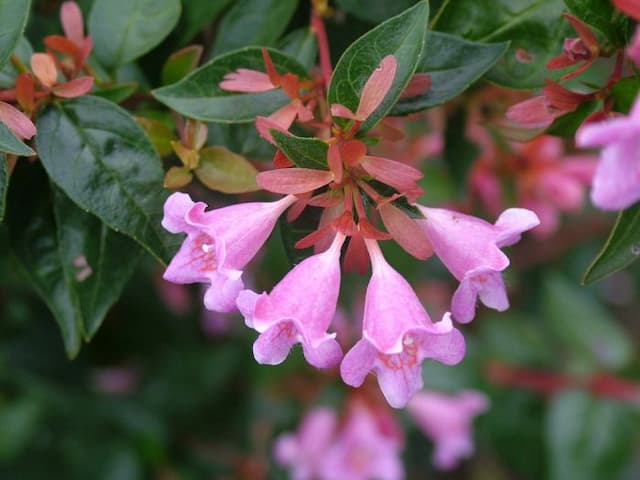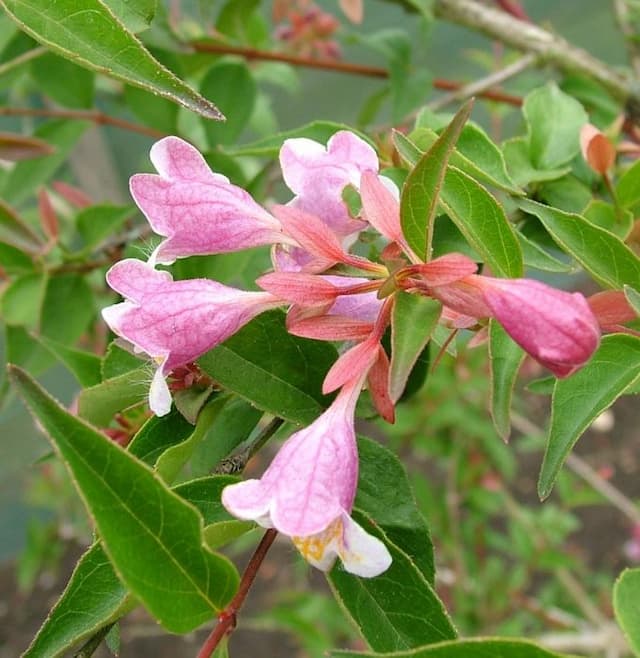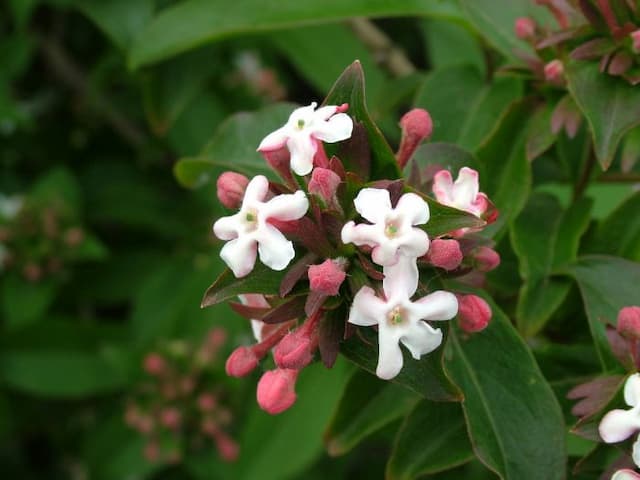Red valerian Centranthus ruber var. coccineus

ABOUT
Centranthus ruber var. coccineus, commonly known as red valerian, is a perennial plant that is well-known for its ornamental appeal. It exhibits a bushy growth habit with lance-shaped, blue-green leaves that provide a lovely contrast to its vibrant blossoms. The flowers of red valerian are its most striking feature; they cluster together in dense, rounded heads at the tips of the stems. These flowers are usually a rich, rosy-red or pink color, although occasionally there can be a white variant. The blossoms are small and tubular, and they tend to attract butterflies and bees, as they offer a plentiful source of nectar. The red valerian blooms profusely from late spring to early autumn, bringing a long-lasting splash of color to gardens and landscapes. The flowers are subtly fragrant and can be used as cut flowers for indoor arrangements. When not in bloom, the foliage remains an attractive feature, forming a mound of greyish-green that adds texture to the garden. As a hardy plant, red valerian adapts well to a range of conditions and can oftentimes be seen spilling from crevices in walls or growing upon rocky outcrops, showcasing its versatility and endurance in various environments. Its ability to thrive in poor soil makes it a popular choice for gardeners looking to add color to less fertile areas. The red valerian's drought tolerance also makes it a valuable plant for xeriscaping or gardens that aim to conserve water.
About this plant
 Names
NamesFamily
Caprifoliaceae.
Synonyms
Red Valerian, Jupiter's Beard, Spur Valerian, Kiss-me-quick, Fox's Brush, Devil's Beard, Pretty Betsy, Sweet Betsy.
Common names
Centranthus ruber, Kentranthus ruber
 Toxicity
ToxicityTo humans
Red valerian (Centranthus ruber var. coccineus) is not considered highly toxic to humans. There is no widespread documentation of severe toxicity, and it is generally regarded as safe. However, as with any plant, individual allergies or sensitivities could occur, potentially resulting in mild gastrointestinal upset or skin irritation if ingested or handled, but such reactions are rare.
To pets
Red valerian (Centranthus ruber var. coccineus) is also not highly toxic to pets. It is not listed as a plant of major concern for pet poisoning. That being said, individual animals could experience mild gastrointestinal discomfort, such as vomiting or diarrhea, if they ingest parts of the plant, due to either the novelty of the plant material or a specific sensitivity. However, there are no well-documented severe toxic effects for pets consuming this plant in normal quantities.
 Characteristics
CharacteristicsLife cycle
Perennials
Foliage type
Semi-deciduous
Color of leaves
Green
Flower color
Red
Height
2-3 feet (60-90 cm)
Spread
1-2 feet (30-60 cm)
Plant type
Herb
Hardiness zones
5-8
Native area
Mediterranean
Benefits
 General Benefits
General Benefits- Attracts Pollinators: The blooms provide nectar for bees and butterflies, supporting local ecosystems and promoting biodiversity.
- Drought Tolerance: Once established, Red Valerian is tolerant to periods of drought, making it suitable for xeriscaping and low-water gardens.
- Low Maintenance: It requires minimal care once established and is not particularly susceptible to pests or diseases.
- Soil Adaptability: It can thrive in a variety of soil conditions, including poor, rocky, or sandy soils where other plants may struggle.
- Erosion Control: Its root system helps stabilize soil on slopes, preventing erosion and loss of topsoil.
- Ornamental Value: Provides a burst of color in garden spaces with its vibrant red-pink flowers that bloom throughout the spring and summer months.
- Wildlife Habitat: Forms part of the habitat for various insects and birds, providing shelter and resources within a garden ecosystem.
- Endurance: It is a perennial plant, which means it can live for more than two years, reducing the need for annual replanting.
- Fast Growth: Rapid growth rate allows for quick establishment and coverage, ideal for new gardens or areas in need of quick greening.
- Self-seeding: Red Valerian can self-propagate through seeds, potentially reducing the need for repurchasing and replanting.
 Medical Properties
Medical PropertiesThis plant is not used for medical purposes.
 Air-purifying Qualities
Air-purifying QualitiesThis plant is not specifically known for air purifying qualities.
 Other Uses
Other Uses- Centranthus ruber, commonly known as red valerian, can be used in cut flower arrangements for its vibrant colour and longevity once cut.
- The dense growth habit of red valerian makes it suitable for use as informal hedging or for providing quick cover in a new garden.
- Red valerian is often planted in butterfly gardens, as it attracts a variety of pollinators, including butterflies and bees.
- The plant can be used for naturalizing in wildflower meadows, contributing to the biodiversity and visual appeal of the landscape.
- Due to its ability to grow in poor soils, red valerian can be used in erosion control schemes on slopes or disturbed land areas.
- The flowers can be used to create a natural dye, giving fabrics a gentle pink or reddish hue.
- Its drought-tolerant nature allows red valerian to be used in xeriscaping, helping conserve water in gardens located in dry regions.
- The seeds of red valerian can be added to seed mixes for birds, as some species are known to eat them.
- Red valerian is suitable for coastal gardens since it can withstand the challenging conditions like salty air and strong winds.
- In culinary use, young leaves of red valerian can be utilized in small amounts for a slight peppery flavor in salads.
Interesting Facts
 Feng Shui
Feng ShuiThe Red Valerian is not used in Feng Shui practice.
 Zodiac Sign Compitability
Zodiac Sign CompitabilityThe Red Valerian is not used in astrology practice.
 Plant Symbolism
Plant Symbolism- Attraction: Commonly known as Red Valerian, its vibrant red color is associated with allure and magnetism, drawing in people and beneficial insects alike.
- Endurance: Red Valerian is known for its hardiness and ability to thrive in tough environments, symbolizing strength and perseverance.
- Adaptability: With its ability to grow in a variety of conditions, Red Valerian represents flexibility and the capacity to adapt to changing circumstances.
- Love: The red hue of the flowers is reminiscent of the heart and passion, making Red Valerian a symbol of deep affection and love.
- Relaxation: As a relative of the Valerian plant, which is famed for its sedative properties, Red Valerian can symbolize restfulness and tranquility.
 Water
WaterRed valerian should be watered deeply and thoroughly to help establish an extensive root system. Once the plant is well-established, it is fairly drought-tolerant and requires less frequent watering. In general, water red valerian every one to two weeks, providing about 1 gallon of water per plant each time, depending on the weather conditions and soil type. During periods of extended dryness and heat, it may need additional water, but always allow the soil to dry out between watering sessions to avoid overwatering.
 Light
LightRed valerian thrives in full sun but can also tolerate part shade. The best spot for the plant is one where it can receive at least 6 to 8 hours of direct sunlight a day. It will flower most abundantly in a location with ample sunlight, but if planted in too much shade, it may become leggy and produce fewer blooms.
 Temperature
TemperatureRed valerian can tolerate a wide temperature range and is hardy in USDA zones 5 through 8. It can survive temperatures as low as 0 Fahrenheit and can handle heat well, but ideal growing temperatures are between 60 and 80 Fahrenheit. Red valerian should not be exposed to temperatures consistently below freezing without some form of cold protection.
 Pruning
PruningPruning red valerian promotes bushier growth and can prevent it from self-sowing excessively. Deadheading spent flowers will encourage a second bloom. Prune back the plant by a third after the initial blooming period, typically in late spring or early summer, to maintain a compact shape and stimulate new blooms for the following season.
 Cleaning
CleaningAs needed
 Soil
SoilThe best soil mix for Red Valerian (Centranthus ruber var. coccineus) should be well-draining with plenty of organic matter such as compost or aged manure. A mixture of loam, coarse sand, and peat is often ideal. Its soil pH preference is neutral to slightly alkaline, around 6.6 to 7.5.
 Repotting
RepottingRed Valerian does not generally require frequent repotting and can thrive in the same pot for several years. However, if the plant becomes root-bound or the soil is exhausted, it can be repotted in the spring. Typically, repotting every 2-3 years is sufficient.
 Humidity & Misting
Humidity & MistingRed Valerian is tolerant of a wide range of humidity levels. This plant typically prefers conditions that are not excessively humid and will do well in average ambient humidity found in most outdoor environments.
 Suitable locations
Suitable locationsIndoor
Place in bright light, limit water, and ensure good air circulation.
Outdoor
Full sun, well-drained soil, and water moderately.
Hardiness zone
5-9 USDA
 Life cycle
Life cycleCentranthus ruber var. coccineus, commonly known as red valerian, begins its cycle as a seed that germinates in late winter to early spring, depending on local climate conditions. Once the seedling emerges, it develops a rosette of leaves at ground level. As the plant matures, it sends up flowering stems that can reach up to 60-90 centimeters in height, blooming with dense clusters of small, star-shaped flowers typically from spring to fall. After pollination by insects, the flowers produce dry, one-seeded fruits called achenes which are dispersed by wind. Red valerian can also spread vegetatively through its root system, forming clumps that enlarge over time. The plant is perennial, meaning it can survive for several years, dying back to the ground in winter and re-sprouting from its base in spring.
 Propogation
PropogationPropogation time
Spring-Early Summer
The most popular method of propagation for the Red Valerian (Centranthus ruber var. coccineus) is by seed. The best time to sow seeds is either in early spring or in autumn/fall. Sowing can be done directly in the desired location in the garden, or seeds can be started indoors in seed trays with well-draining soil. To encourage germination, maintain a soil temperature of approximately 65 to 70 degrees Fahrenheit (18 to 21 degrees Celsius). Once the seedlings have developed a couple of true leaves, they can be transplanted to their final location, ensuring they're spaced about 18 inches (45 centimeters) apart to allow sufficient room for growth.







![Himalayan honeysuckle [Golden Lanterns]](/_next/image?url=https%3A%2F%2Fplants-admin.emdemapps.com%2Fimages%2Fplants%2F%2Fimages%2F604b55302cc87.png&w=640&q=75)

